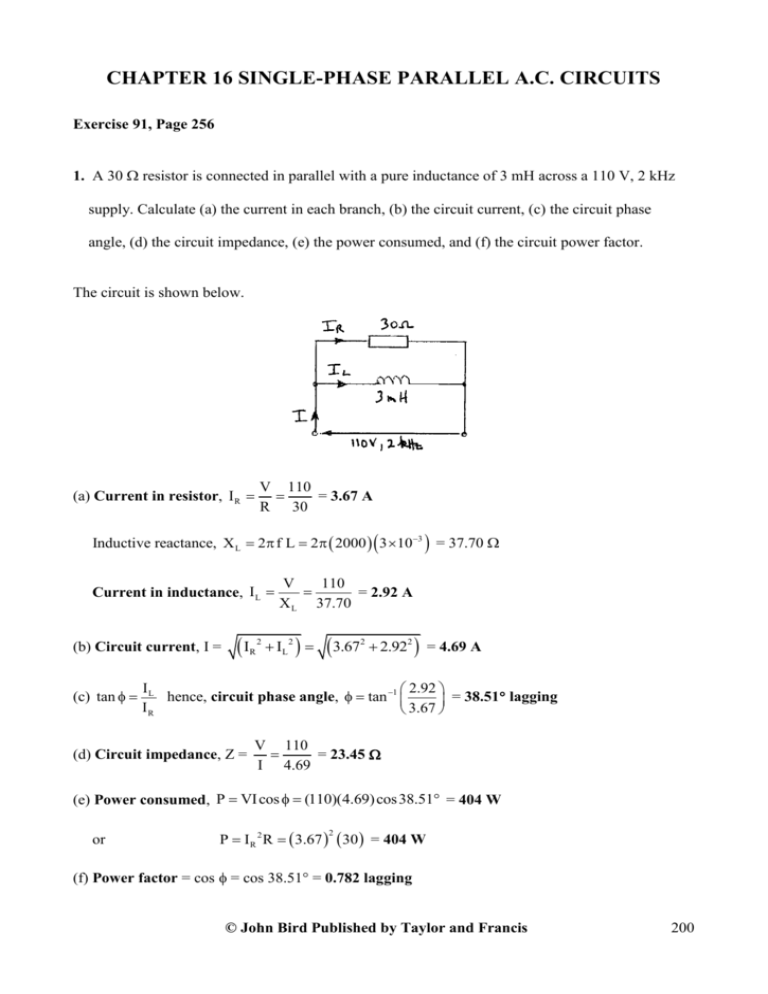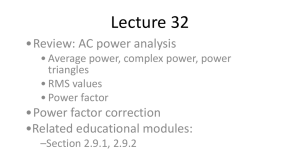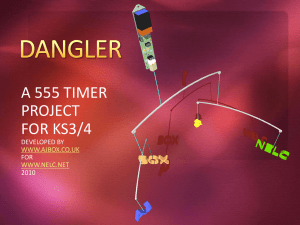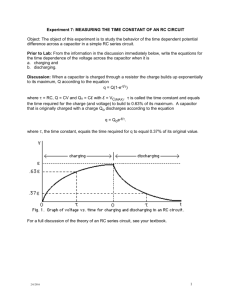Chapter 16
advertisement

CHAPTER 16 SINGLE-PHASE PARALLEL A.C. CIRCUITS Exercise 91, Page 256 1. A 30 resistor is connected in parallel with a pure inductance of 3 mH across a 110 V, 2 kHz supply. Calculate (a) the current in each branch, (b) the circuit current, (c) the circuit phase angle, (d) the circuit impedance, (e) the power consumed, and (f) the circuit power factor. The circuit is shown below. (a) Current in resistor, I R V 110 = 3.67 A R 30 Inductive reactance, X L 2 f L 2 2000 3 103 = 37.70 Current in inductance, I L (b) Circuit current, I = (c) tan I 2 R V 110 = 2.92 A X L 37.70 IL 2 3.67 2 2.922 = 4.69 A IL 2.92 hence, circuit phase angle, tan 1 = 38.51 lagging IR 3.67 (d) Circuit impedance, Z = V 110 = 23.45 I 4.69 (e) Power consumed, P VI cos (110)(4.69) cos 38.51 = 404 W or P I R 2 R 3.67 30 = 404 W 2 (f) Power factor = cos = cos 38.51 = 0.782 lagging © John Bird Published by Taylor and Francis 200 2. A 40 resistance is connected in parallel with a coil of inductance L and negligible resistance across a 200 V, 50 Hz supply and the supply current is found to be 8 A. Sketch the phasor diagram and determine the inductance of the coil. The circuit diagram is shown in (a) below. (a) Current, I R (b) V 200 =5A R 40 From the phasor diagram in diagram (b) above, I current IL Inductive reactance, X L from which, V IL 2 IR 2 82 52 = 6.245 i.e. 2 f L inductance, L = 200 6.245 200 = 0.102 H or 102 mH 6.245 250 © John Bird Published by Taylor and Francis 201 Exercise 92, Page 257 1. A 1500 nF capacitor is connected in parallel with a 16 resistor across a 10 V, 10 kHz supply. Calculate (a) the current in each branch, (b) the supply current, (c) the circuit phase angle, (d) the circuit impedance, (e) the power consumed, (f) the apparent power, and (g) the circuit power factor. Sketch the phasor diagram The circuit diagram is shown in (i) below. (i) (ii) (a) Current in resistor, I R V 10 = 0.625 A R 16 Capacitive reactance, X C 1 1 = 10.61 3 2fC 2 10 10 1500 109 Current in capacitor, IC V 10 = 0.943 A X L 10.61 (b) Supply current, I = I 2 R IC 2 0.625 2 0.9432 = 1.131 A IC 0.943 hence, circuit phase angle, tan 1 = 56.46 leading, as shown in the IR 0.625 phasor diagram in (ii) above V 10 (d) Circuit impedance, Z = = 8.84 I 1.131 (c) tan (e) Power consumed, P VI cos (10)(1.131) cos 56.46 = 6.25 W or P I R 2 R 0.625 16 = 6.25 W 2 (f) Apparent power, S = VI = (10)(1.131) = 11.31 VA (g) Power factor = cos = cos 56.46 = 0.553 leading © John Bird Published by Taylor and Francis 202 2. A capacitor C is connected in parallel with a resistance R across a 60 V, 100 Hz supply. The supply current is 0.6 A at a power factor of 0.8 leading. Calculate the values of R and C. The circuit diagram is shown in (a) below. (a) (b) Power factor = cos = 0.8 hence, cos 1 0.8 = 36.87 leading From the phasor diagram in (b) above, current in resistor, IR I cos 0.6cos36.87 = 0.48 A and current in capacitor, IC Isin 0.6sin 36.87 = 0.36 A Resistance, R = V 60 = 125 I R 0.48 Capacitive reactance, X C from which, 1 V 60 = 166.67 = 2fC IC 0.36 capacitance, C = 1 166.67 2100 = 9.55 F © John Bird Published by Taylor and Francis 203 Exercise 93, Page 259 1. An inductance of 80 mH is connected in parallel with a capacitance of 10 F across a 60 V, 100 Hz supply. Determine (a) the branch currents, (b) the supply current, (c) the circuit phase angle, (d) the circuit impedance, and (e) the power consumed. The circuit diagram is shown in (i) below. (i) (ii) (a) Inductive reactance, X L 2 f L 2 100 80 103 = 50.265 Hence, current in inductance, I L Capacitive reactance, X C V 60 = 1.194 A X L 50.265 1 1 = 159.155 2fC 2 100 10 106 Hence, current in capacitor, IC V 60 = 0.377 A X C 159.155 (b) Supply current, I = IL IC = 1.194 – 0.377 = 0.817 A (c) From the phasor diagram in (ii) above, circuit phase angle, = 90 lagging (d) Impedance, Z = V 60 = 73.44 I 0.817 (e) Power consumed, P = VI cos (60)(0.817) cos 90 = 0 W 2. Repeat problem 1 for a supply frequency of 200 Hz. (a) Inductive reactance, X L 2 f L 2 200 80 103 = 100.53 © John Bird Published by Taylor and Francis 204 Hence, current in inductance, I L Capacitive reactance, X C V 60 = 0.597 A X L 100.53 1 1 = 79.577 2fC 2 200 10 106 Hence, current in capacitor, IC V 60 = 0.754 A X C 79.577 (b) Supply current, I = IC IL = 0.754 – 0.597 = 0.157 A (c) From the phasor diagram in below, circuit phase angle, = 90 leading (d) Impedance, Z = V 60 = 382.2 I 0.157 (e) Power consumed, P = VI cos (60)(0.157) cos 90 = 0 W © John Bird Published by Taylor and Francis 205 Exercise 94, Page 261 1. A coil of resistance 60 and inductance 318.4 mH is connected in parallel with a 15 F capacitor across a 200 V, 50 Hz supply. Calculate (a) the current in the coil, (b) the current in the capacitor, (c) the supply current and its phase angle, (d) the circuit impedance, (e) the power consumed, (f) the apparent power and (g) the reactive power. Sketch the phasor diagram. The circuit is shown in (i) below. (i) (ii) (a) X L 2 f L 2 50 318.4 103 100 Hence, ZLR R 2 XL 2 60 2 1002 116.62 Current in coil, I LR V 200 = 1.715 A ZLR 116.62 Phase angle, tan 1 XL 100 tan 1 = 59.04 lagging R 60 (b) X C 1 1 212.2 2fC 2 50 15 106 Current in capacitor, IC V 200 = 0.943 A leading by 90 X C 212.2 The phasor diagram is shown in (ii) above. (c) Horizontal component of ILR ILR cos59.04 1.715cos59.04 0.8823 A Horizontal component of IC IC cos90 = 0 Total horizontal component = 0.8823 + 0 = 0.8823 A © John Bird Published by Taylor and Francis 206 Vertical component of ILR ILR sin 59.04 1.715sin 59.04 1.4707 A Vertical component of IC IC sin 90 0.943sin 90 0.943 A Total vertical component = -1.4707 + 0.943 = - 0.5277 A From the diagram below, resultant current, I = 0.8823 2 0.52772 = 1.028 A 0.5277 Phase angle, tan 1 = 30.88 lagging 0.8823 (d) Circuit impedance, Z = V 200 = 194.6 I 1.028 (e) Power consumed, P = V I cos = (200)(1.028) cos 30.88 = 176.5 W or P = I LR 2 R 1.715 60 = 176.5 W 2 (f) Apparent power, S = V I = (200)(1.028) = 205.6 VA (g) Reactive power, Q = (200)(1.028) sin 30.88 = 105.5 var The phasor diagram is shown sketched in (ii) above. 2. A 25 nF capacitor is connected in parallel with a coil of resistance 2 k and inductance 0.20 H across a 100 V, 4 kHz supply. Determine (a) the current in the coil, (b) the current in the capacitor, (c) the supply current and its phase angle, (d) the circuit impedance, and (e) the power consumed. The circuit diagram is shown in (i) below. (a) XL 2 f L 2 4000 0.2 5026.55 Hence, ZLR R 2 XL 2 2000 2 5026.552 5410 © John Bird Published by Taylor and Francis 207 Current in coil, I LR V 100 = 18.48 mA ZLR 5410 Phase angle, tan 1 XL 5026.55 tan 1 = 68.30 lagging R 2000 (i) (b) X C (ii) 1 1 1591.55 2fC 2 4000 25 109 Current in capacitor, IC V 100 = 62.83 mA leading by 90 X C 1591.55 The phasor diagram is shown in (ii) above. (c) Total horizontal component = 18.48 cos 68.30 + 62.83 cos 90 = 6.833 mA Total vertical component = - 18.48 sin 68.30 + 62.83 sin 90 = 45.660 mA From the diagram below, resultant current, I = 6.833 2 45.6602 = 46.17 mA 45.66 Phase angle, tan 1 = 81.49 leading 6.833 (d) Circuit impedance, Z = V 100 = 2166 I 46.17 103 or 2.166 k (e) Power consumed, P = V I cos = (100) (46.17 103 )2 cos 81.49 = 0.683 W © John Bird Published by Taylor and Francis 208 or P = ILR 2 R 18.48 103 2000 = 0.683 W 2 © John Bird Published by Taylor and Francis 209 Exercise 95, Page 265 1. A 0.15 μF capacitor and a pure inductance of 0.01 H are connected in parallel across a 10 V, variable frequency supply. Determine (a) the resonant frequency of the circuit, and (b) the current circulating in the capacitor and inductance. (a) Parallel resonant frequency, fr = 1 1 R2 1 1 when R = 0 2 LC L2 2 LC = 1 1 6 2 (0.01)(0.15 10 ) = 1 (25819.0) = 4109 Hz = 4.11 kHz 2 (b) Current circulating in L and C at resonance, ICIRC = Hence, V V = = 2π fr C V XC 1 2f r C ICIRC = 2π(4109)(0.15 × 10-6)(10) = 0.03873 = 38.73 mA (Alternatively, ICIRC = 10 V V = = = 38.73 mA) XL 2f r L 2(4109)(0.01) 2. A 30 F capacitor is connected in parallel with a coil of inductance 50 mH and unknown resistance R across a 120 V, 50 Hz supply. If the circuit has an overall power factor of 1 find (a) the value of R, (b) the current in the coil, and (c) the supply current. The circuit is shown below. © John Bird Published by Taylor and Francis 210 Since power factor = 1, then cos = 1 and cos 1 1 0 , hence the circuit is at resonance. 1 1 R2 (a) Resonant frequency, f r 2 LC L2 1 1 R2 50 = 2 50 103 30 106 50 103 2 i.e. R2 2(50) 666.667 103 0.0025 and 2 50 666.667 103 400R 2 2 i.e. 400R 2 666.667 103 2 50 567.97 103 2 Hence, from which, and R2 567.97 103 1419.927 400 resistance, R = 1419.927 = 37.68 (b) X L 2 50 50 103 15.71 Hence, ZLR R 2 XL 2 and current in the coil, I LR (c) Current at resonance, I r = 37.68 2 15.712 = 40.824 V 120 = 2.94 A ZLR 40.824 V V VCR L RD L CR 120 37.7 30 10 6 50 103 = 2.714 A 3. A coil of resistance 25 and inductance 150 mH inductance is connected in parallel with a 10 F capacitor across a 60 V, variable frequency supply. Calculate (a) the resonant frequency, (b) the dynamic resistance, (c) the current at resonance and (d) the Q-factor at resonance. © John Bird Published by Taylor and Francis 211 The circuit is shown below. (a) Resonant frequency, f r 1 1 R2 1 2 LC L2 2 = 1 2 1 252 150 103 10 106 150 103 2 666.667 10 (b) Dynamic resistance, R D L 150 103 = 600 CR 10 106 25 (c) Current at resonance, I r V 60 = 0.10 A R D 600 3 27.778 103 = 127.2 Hz 3 2f r L 2 127.2 150 10 (d) Q-factor = = 4.80 R 25 4. A coil having resistance R and inductance 80 mH is connected in parallel with a 5 nF capacitor across a 25 V, 3 kHz supply. Determine for the condition when the current is a minimum, (a) the resistance R of the coil, (b) the dynamic resistance, (c) the supply current, and (d) the Q-factor. (a) The supply current is a minimum when the parallel circuit is at resonance 1 1 R2 and resonant frequency, fr = 2 LC L2 Transposing for R gives: (2πfr)2 = 1 R2 - 2 LC L 1 R2 = - (2πfr)2 2 LC L and 2 1 R 2 L2 2f r LC © John Bird Published by Taylor and Francis 212 1 2 R L2 2f r LC from which, When L = 80 mH, C = 5 109 F and fr = 3000 Hz, then resistance, R = 2 1 2 80 103 2 3000 3 9 80 10 5 10 = 3704.9 Ω = 3.705 kΩ (b) Dynamic resistance, R D L 80 103 = 4.318 k CR 5 109 3.705 103 (c) Supply current at resonance, I r V 25 = 5.79 mA R D 4.318 103 2f r L 2 3000 80 10 (d) Q-factor = R 3.705 103 3 = 0.41 5. A coil of resistance 1.5 k and 0.25 H inductance is connected in parallel with a variable capacitance across a 10 V, 8 kHz supply. Calculate (a) the capacitance of the capacitor when the supply current is a minimum, (b) the dynamic resistance, and (c) the supply current. The circuit is shown below. Since the supply current is a minimum, the circuit is at resonance. (a) Resonant frequency, from which, fr 2 f r 2 1 1 R2 2 LC L2 1 R2 LC L2 © John Bird Published by Taylor and Francis 213 i.e. 2 f r 2 R2 1 2 L LC from which, capacitance, C = 1 R 2 L 2 f r 2 L 2 1 2 15002 0.25 2 8000 0.252 = 1561 pF (b) Dynamic resistance, R D L 0.25 = 106.769 k or 106.8 k CR 15611012 1.5 103 (c) Current at resonance, I r V 10 = 93.66 A R D 106.769 103 6. A parallel circuit as shown below is tuned to resonance by varying capacitance C. Resistance, R = 30 , inductance, L = 400 H, and the supply voltage, V = 200 V, 5 MHz. Calculate (a) the value of C to give resonance at 5 MHz, (b) the dynamic impedance, (c) the Q-factor, (d) the bandwidth, (e) the current in each branch, (f) the supply current, and (g) the power dissipated at resonance. 1 1 R2 (a)Transposing f r for C: 2 LC L2 2f r from which, 1 R2 2 LC L 2f r 2 R2 1 2 L LC and and 2f r 2 1 R2 LC L2 1 2f r 2 R2 2 L LC © John Bird Published by Taylor and Francis 214 and C= i.e. 1 R 2 L 2f r 2 L 2 1 2 30 6 2 400 10 2 5 10 2 400 106 6 capacitance, C = 2.533 pF (b) Dynamic impedance, Z D = (c) Q-factor = L 400 106 = 5.264 M CR 2.533 1012 30 X L 2f r L 2(5 106 )(400 106 ) = 418.9 R R 30 (d) Bandwidth, f 2 f1 f r 5 106 = 11.94 kHz Q 418.9 (e) Capacitive current, IC = V 2000 XC 1 90 2 5 106 2.533 1012 = 2000 12566.517 90 = 0.01591590 or 15.91590mA Inductive branch current, I LR = = V V 2000 ZLR R jX L 30 j 2 5 106 400 106 2000 2000 30 j12566.3706 12566.4064 89.863 = 15.915-89.863mA (f) Supply current, I r = Alternatively, V 200 = 38 A ZD 5.264 10 6 Ir IC ILR 15.91590 15.915 89.863 mA = (0 + j15.915) + (0.038 – j15.915) = 0.038 mA or 38 A (g) Power, P = V I cos = (200)(38 10 6 ) cos 0 = 7.60 mW © John Bird Published by Taylor and Francis 215 Alternatively, P = IR 2 R 15.915 103 (30) = 7.60 mW 2 (Note that if the latter formula is used, the current must be the current flowing through the resistor, i.e. I LR in the above circuit) © John Bird Published by Taylor and Francis 216 Exercise 96, Page 270 1. A 415 V alternator is supplying a load of 55 kW at a power factor of 0.65lagging. Calculate (a) the kVA loading and (b) the current taken from the alternator. (c) If the power factor is now raised to unity find the new kVA loading. (a) Power = VI cos = (VI)(power factor) Hence VI = power 55 10 3 = = 84615 VA = 84.6 kVA p.f . 0.65 (b) VI = 84615 VA hence I = 84615 84615 = = 203.9 A V 415 (c) The kVA loading remains at 84.6 kVA irrespective of changes in power factor 2. A single phase motor takes 30 A at a power factor of 0.65 lagging from a 240 V, 50 Hz supply. Determine (a) the current taken by the capacitor connected in parallel to correct the power factor to unity, and (b) the value of the supply current after power factor correction. The circuit diagram is shown below in (i) and the phasor diagram is shown in (ii). (i) (ii) (a) Power factor = cos = 0.65 from which, phase angle, = cos 1 0.65 = 49.46 For unity power factor, current taken by capacitor, IC = ab in the phasor diagram = 30 sin 49.46 = 22.80 A (b) After power factor correction, new supply current = oa in the above phasor diagram = 30 cos 49.46 = 19.50 A © John Bird Published by Taylor and Francis 217 3. A 20 non-reactive resistor is connected in series with a coil of inductance 80 mH and negligible resistance. The combined circuit is connected to a 200 V, 50 Hz supply. Calculate (a) the reactance of the coil, (b) the impedance of the circuit, (c) the current in the circuit, (d) the power factor of the circuit, (e) the power absorbed by the circuit, (f) the value of a power factor correction capacitor to produce a power factor of unity, and (g) the value of a power factor correction capacitor to produce a power factor of 0.9 (a) Inductive reactance, X L 2 f L 2 50 80 103 = 25.13 (b) Circuit impedance, ZLR R jXL 20 j25.13 = 32.1251.49 (c) Circuit current, I LR V 2000 = 6.227-51.49 A ZLR 32.1251.49 (d) Power factor = cos = cos 51.49 = 0.623 (e) Power, P = I LR 2 R 6.227 20 = 775.5 W 2 (f) The circuit including the capacitor is shown below in (i) and the phasor diagram in (ii). (i) (ii) Power factor = cos = 1 from which = 0 Hence the new circuit current I is shown as oa in diagram (ii). Capacitor current, IC ab 6.227sin 51.49 = 4.873 A. IC which, capacitance, C = V XC V 2 f C V 1 2 f C from IC 4.873 = 77.56 F 2 f V 2 50 200 © John Bird Published by Taylor and Francis 218 (g) Power factor = cos = 0.9 from which, = cos 1 0.9 = 25.84 The phasor diagram is shown in (iii) below where IC bc ab ac (iii) ab = 4.873 A from part (f) ac ac oa 3.877 tan 25.84 = and oa = 6.227 cos 51.49 = 3.877 A from which, ac = 3.877 tan 25.84 = 1.878 A Hence, bc = ab – ac = 4.873 – 1.878 = 2.995 A = IC IC V XC V 2 f C V 1 2 f C capacitance, C = from which, IC 2.995 = 47.67 F 2 f V 2 50 200 4. A motor has an output of 6 kW, an efficiency of 75% and a power factor of 0.64 lagging when operated from a 250 V, 60 Hz supply. It is required to raise the power factor to 0.925 lagging by connecting a capacitor in parallel with the motor. Determine (a) the current taken by the motor, (b) the supply current after power factor correction, (c) the current taken by the capacitor, (d) the capacitance of the capacitor, (d) the capacitance of the capacitor and (e) the kvar rating of the capacitor. (a) Efficiency = from which, Hence, power output power input hence, 75 6000 100 power input power input = 6000 = 8000 W 0.75 8000 = VIM cos 250 IM 0.64 since cos = power factor = 0.64 where cos1 0.64 50.21 © John Bird Published by Taylor and Francis 219 Current taken by motor, IM 8000 = 50 A 250 0.64 (b) To improve the power factor to 0.925 lagging, the new phase angle = cos 1 0.925 22.33 as shown in the phasor diagram below. After power factor correction, the supply current is shown as I in the phasor diagram. In triangle oab, oa = 50 cos 50.21 = 32 A and ab = In triangle oac, cos 22.33 = 502 322 = 38.42 A by Pythagoras oa 32 32 from which, current, I = oc = = 34.59 A oc oc cos 22.33 (c) The current taken by the capacitor, IC , is given by length bc, where bc = ab – ac ac = 34.59 sin 22.33 = 13.14 Hence, capacitor current, IC = bc = ab – ac = 38.42 – 13.14 = 25.28 A (d) Capacitive reactance, X C i.e. V 250 9.89 IC 25.28 1 1 1 9.89 from which, capacitance, C = = 268.2 F 2 f C 2 f 9.89 2 60 9.89 (e) The kvar rating of the capacitor = V IC 250 25.28 = 6.32 kvar 1000 1000 5. A supply of 250 V, 80 Hz is connected across an inductive load and the power consumed is 2 kW, when the supply current is 10 A. Determine the resistance and inductance of the circuit. What value of capacitance connected in parallel with the load is needed to improve the overall power factor to unity ? © John Bird Published by Taylor and Francis 220 Power, P = I2 R hence, 2000 = (10)2 R from which, resistance, R = Impedance, Z = 2000 = 20 Ω 10 2 V 250 = 25 Ω I 10 Impedance, Z = R 2 X L 2 from which, X L Z2 R 2 252 202 = 15 Ω X L 2 f L from which, inductance, L = XL 15 = 29.84 mH 2f 2(80) The circuit including the capacitor is shown below in (i) and the phasor diagram in (ii). (i) (ii) Power factor = cos = 1 from which = 0 Hence the new circuit current I is shown as oa in diagram (ii). X 15 tan 1 L tan 1 = 36.87º 20 R Capacitor current, IC ab 10sin 36.87 = 6 A. IC which, capacitance, C = V XC V 2 f C V 1 2 f C from IC 6 = 47.75 F 2 f V 2 80 250 6. A 200 V, 50 Hz single-phase supply feeds the following loads: (i) fluorescent lamps taking a current of 8 A at a power factor of 0.9 leading, (ii) incandescent lamps taking a current of 6 A at unity power factor, (iii) a motor taking a current of 12 A at a power factor of 0.65 lagging. Determine the total current taken from the supply and the overall power factor. Find also the value of a static capacitor connected in parallel with the loads to improve the overall power factor to 0.98 lagging © John Bird Published by Taylor and Francis 221 (i) Fluorescent lamps take a current of 8 A at a phase angle of cos 1 0.9 leading, i.e. 25.84 leading (ii) Incandescent lamps take a current of 6 A at a phase angle of cos 1 1 , i.e. 0 (iii) Motor takes a current of 12 A at a phase angle of cos 1 0.65 lagging, i.e. 49.46 lagging These currents are shown in the phasor diagram below. Total horizontal component of currents = 8 cos 25.84 + 6 cos 0 + 12 cos 49.46 = 7.20 + 6.00 + 7.80 = 21.0 A Total vertical component of currents = 8 sin 25.84 + 6 sin 0 - 12 sin 49.46 = 3.487 + 0 – 9.119 = - 5.632 A Total supply current, I = 21.02 5.6322 = 21.74 A 5.632 at a phase angle of tan 1 = 15.01 lagging 21.0 Hence, power factor = cos 15.01 = 0.966 lagging If power factor is 0.98, then cos = 0.98 and = cos 1 0.98 11.48 If a capacitor is connected in parallel with the loads, the capacitor current, IC , is as shown in the phasor diagram below, where IC = length bc From triangle oac, oa = horizontal component of I = 21.0 A © John Bird Published by Taylor and Francis 222 and ac = vertical component of I = 21.72 sin 15.01 = 5.631 A From triangle oab, tan 11.48 = ab ab from which, ab = 21.0tan11.48 = 4.265 A oa 21.0 Hence, capacitor current, IC = ac – ab = 5.631 – 4.265 = 1.366 A IC V XC IC 1.366 V = 21.74 F 2 f C V from which, capacitance, C = 1 2 f V 2 50 200 2 f C © John Bird Published by Taylor and Francis 223
![Sample_hold[1]](http://s2.studylib.net/store/data/005360237_1-66a09447be9ffd6ace4f3f67c2fef5c7-300x300.png)






